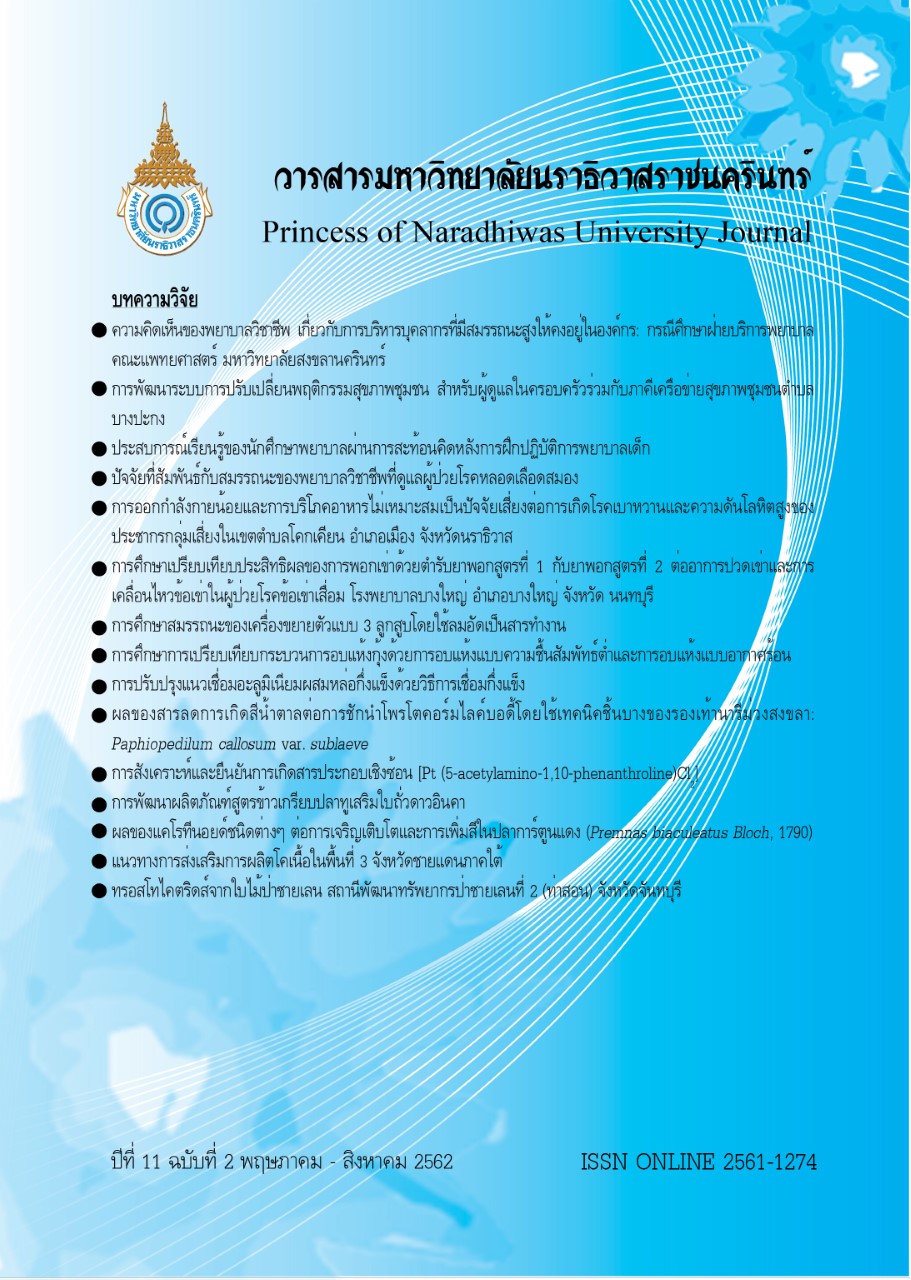การบูรณาการอินเทอร์เน็ตของสรรพสิ่งกับระบบบริหารทรัพยากรองค์กรเพื่อการบริหารสถานศึกษา
คำสำคัญ:
อินเทอร์เน็ตของสรรพสิ่ง, ระบบบริหารทรัพยากรองค์กร, การบริหารสถานศึกษาบทคัดย่อ
ในสถานศึกษา ERP ได้มีบทบาทสำคัญในการบริหารจัดการด้านไอทีของการศึกษาระดับอุดมศึกษารวมทั้งระบบทรัพยากรมนุษย์ ระบบข้อมูลนักเรียนและ ระบบการเงิน บทความทางวิชาการนี้เป็นการศึกษาเอกสารและงานวิจัยที่เกี่ยวข้องกับการบูรณาการอินเทอร์เน็ตของสรรพสิ่งกับระบบบริหารทรัพยากรองค์กรเพื่อการบริหารสถานศึกษาบทความนี้มีวัตถุประสงค์ประเด็นหลักคือแนวคิดการบูรณาการเทคโนโลยีอินเทอร์เน็ตของสรรพสิ่งและระบบบริหารทรัพยากรองค์กรเพื่อการบริหารสถานศึกษา กระบวนการศึกษาเริ่มจากการศึกษาเอกสารทั่วไปและงานวิจัยที่เกี่ยวข้องนำมาวิเคราะห์และสังเคราะห์ โดยผู้เขียนนำเสนอในบริบท คือ 1)ระบบบริหารทรัพยากรองค์กร (Enterprise Resource Planning System : ERPs) 2)องค์ประกอบของ ERP ในองค์กร 3)ระบบ Cloud ERP ในองค์กร 4)การบูรณาการ ERP เพื่อการบริหารสถานศึกษา 5)ปัจจัยที่เกี่ยวข้องกับระบบ ERP 6)การยอมรับการใช้งานระบบ ERP 7)IoT : Internet of Things 8)แนวโน้มการบูรณาการ IoT กับ ERP นอกจากนี้จำเป็นต้องศึกษาเพิ่มเติมในเรื่องปัจจัยที่ทําให้คนยอมรับเทคโนโลยีและการนําเทคโนโลยีนั้นไปใช้ให้เกิดประโยชน์สูงสุดในสถานศึกษาต่อไป
เอกสารอ้างอิง
Technologies and Computers (ICETC), 2014 The International Conference on (pp. 73-78). IEEE.
Ali, M., Nasr, E. S., & Gheith, M. H. (2016). A requirements elicitation approach for cloud based software
product line ERPs. In Proceedings of the 2nd Africa and Middle East Conference on Software Engineering (pp. 34-39). ACM.
Althonayan, M., & Papazafeiropoulou, A. (2013). Evaluating the performance on ERP systems in King
Saud University (KSU): A stakeholders' perspective. In System Sciences (HICSS), 2013 46th Hawaii International Conference on (pp. 4074-4083). IEEE.
Ballon, P. (2007). Changing business models for Europe’s mobile telecommunications industry: The
impact of alternative wireless technologies. Telematics and Informatics, 24(3), 192-205.
Basole, R. C. (2009). Visualization of interfirm relations in a converging mobile ecosystem. Journal of
information Technology, 24(2), 144-159.
Bhat, J. M., Shroff, B., & Bandi, R. K. (2013). User Perceptions, Motivations and Implications on ERP
Usage: An Indian Higher Education Context. In Enterprise Information Systems of the Future: 6th IFIP WG 8.9 Working Conference, CONFENIS 2012, Ghent, Belgium, September 19-21, 2012, Revised Selected Papers (Vol. 139, p. 90). Springer.
Chan, T., Sedera, D., & Gable, G. G. (2008). Re-conceptualizing Information System Success: The IS-
Impact Measurement Model. Journal of the Association for Information Systems, 9(7), 2.
Chaudhari., Sonu. A. Mathurawala., Siddesh. P. Tupe., Priyanka. R. Dake., & Omkar. R. Dake.
(2015). Implementation of Online ERP System for Educational Institutes. International Journal of Advanced Research in Computer Engineering & Technology (IJARCET), 4(4), 1114-1116.
Cusumano, M. A., & Gawer, A. (2002). The elements of platform leadership. MIT Sloan management
review, 43(3), 51.
de Castro Silva, S. L. F., & de Oliveira, S. B. (2015). Planning and scope definition to implement ERP:
the case study of Federal Rural University of Rio de Janeiro (UFRRJ). Procedia Computer Science, 64, 196-203.
Guinard, D., Trifa, V., Karnouskos, S., Spiess, P., & Savio, D. (2010). Interacting with the soa-based
internet of things: Discovery, query, selection, and on-demand provisioning of web services. IEEE transactions on Services Computing, 3(3), 223-235.
Helo, P., Anussornnitisarn, P., & Phusavat, K. (2008). Expectation and reality in ERP implementation:
consultant and solution provider perspective. Industrial Management & Data Systems, 108(8), 1045-1059.
Iansiti, M., & Levien, R. (2004). The Keystone Advantage: What the New Dynamics of Business
Ecosystems Mean for Strategy, Innovation, and Sustainability: Harvard Business School Press. Boston, MA.
Jalil, D., & Bakar, M. S. A. (2017). Adapting Software Factory Approach into Cloud ERP Production
Model. International Journal of Computer Science and Information Security, 15(1), 221-229.
Mudaly, S., Singh, P., & Olugbara, O. O. (2013). Improved technology acceptance model
applied to study enterprise resource planning usage. In Science and Information Conference (SAI), 2013 (pp. 782-790). IEEE.
Majeed, A. A., & Rupasinghe, T. D. (2017). Internet of things (IoT) embedded future supply chains for
industry 4.0: An assessment from an ERP-based fashion apparel and footwear industry.
International Journal of Supply Chain Management, 6(1), 25-40.
Noaman, A. Y., & Ahmed, F. F. (2015). ERP systems functionalities in higher education. Procedia
Computer Science, 65, 385-395.
Papert, M., & Pflaum, A. (2017). Development of an ecosystem model for the realization of internet of
things (IoT) services in supply chain management. Electronic Markets, 27(2), 175-189.
Pollock, N., & Cornford, J. (2005). Implications of enterprise resource planning systems for
universities: An analysis of benefits and risks.
Reich, J., & SE, S. (2017). Interaction semantics–and its implications for an interaction oriented
architecture of IoT-type applications.
Rosemann, M., & Wiese, J. (1999). Measuring the performance of ERP software–a balanced
scorecard approach. In Proceedings of the 10th Australasian Conference on Information Systems (Vol. 8, No. 4). Wellington.
Rabaa'i, A. A., Bandara, W., & Gable, G. (2009). ERP systems in the higher education sector:
a descriptive study. In Proceedings of the 20th Australasian Conference on Information Systems (pp. 456-470).
Rong, K., Shi, Y., & Yu, J. (2013). Nurturing business ecosystems to deal with industry uncertainties.
Industrial management & data systems, 113(3), 385-402.
Ritala, P., Agouridas, V., Assimakopoulos, D., & Gies, O. (2013). Value creation and capture mechanisms
in innovation ecosystems: a comparative case study. International Journal of Technology Management, 63(3-4), 244-267.
Ram, J., Wu, M. L., & Tagg, R. (2014). Competitive advantage from ERP projects: Examining the role of
key implementation drivers. International Journal of Project Management, 32(4), 663-675.
Solaimani, S., Bouwman, H., & De Reuver, M. (2010). Smart home: aligning business models and
providers processes; a case survey. Proceedings of 21st ACIS, 55-81.
Wu, J. H., & Wang, Y. M. (2006). Measuring ERP success: the ultimate users' view. International
Journal of Operations & Production Management, 26(8), 882-903.
Zhu, Y., Li, Y., Wang, W., & Chen, J. (2010). What leads to post-implementation success of ERP? An
empirical study of the Chinese retail industry. International Journal of Information Management, 30(3), 265-276.




